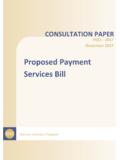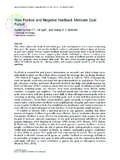Transcription of OECD/IFP Project on Future Global Shocks
1 IFP/WKP/FGS(2011)5 MULTI-DISCIPLINARY ISSUES INTERNATIONAL FUTURES PROGRAMME OECD/IFP Project on Future Global Shocks Social unrest By Ortwin Renn, Aleksandar Jovanovic and Regina Schr ter EU-VRi - European Virtual Institute for Integrated Risk Management, Stuttgart, Germany Contact persons OECD: Pierre-Alain Schieb: +33 (0)1 45 24 82 70; Anita Gibson:+33 (0)1 45 24 96 27 ; Contact persons EU-VRi ( ): Ortwin Renn: +49 711 6858 3970 Aleksandar Jovanovic: +49 711 1839 781 14th January 2011 This report was written by Ortwin Renn, Aleksandar Jovanovic and Regina Schr ter as a contribution to the OECD Project Future Global Shocks .
2 The opinions expressed and arguments employed herein are those of the authors, and do not necessarily reflect the official views of the Organisation or of the governments of its member countries. Page ii Contents Preamble .. iv Introduction Scope of work .. 1 Social unrest as systemic risk .. 4 Case histories .. 7 Financial crisis: Greece 2010 .. 7 What do we learn from this case? .. 8 Pandemic flue: H1N1 9 What do we learn from this case? .. 9 Cyber security .. 10 Infrastructure damage related to social unrest .. 10 What do we learn from this case?
3 10 Hurricane Katrina .. 11 What can we learn from this case? .. 12 Comparison of Cases .. 13 What did we learn? .. 17 Basic model .. 18 Definition and related fields of research .. 18 Political participation .. 18 Collective (political) violence .. 19 Social protest movements .. 20 Structure: A stepwise approach to conceptualize social unrest .. 21 Step 1: Communication of dissatisfaction .. 24 Conclusion of Step 1 .. 25 Step 2: Organization of protest .. 26 Conclusion of Step 2 .. 27 Step 3: Mobilization of protest groups .. 27 Conclusion of Step 3.
4 28 Page iii Step 4: Acts of organized civil violence .. 29 Conclusion of Step 4 .. 30 Reflection of the theoretical model .. 31 Fit between the theoretical model and the case studies .. 31 Drivers - A Synopsis between the analytical model and the results from the case studies .. 34 System for modelling social unrest .. 38 Modeling and simulation of social unrest .. 38 Agent based models for modeling social unrest .. 39 Applicability of ABMs to past and Future cases of social unrest .. 41 Normative governance .. 43 Pre-Estimation .. 45 Interdisciplinary Risk Estimation.
5 46 Risk Evaluation .. 47 Risk Management .. 49 Some concluding remarks and recommendations .. 52 Some concluding remarks .. 52 Main recommendations related to policy makers and governance 53 Main recommendations related to the System/Tool and Future R&D .. 53 References .. 55 Ortwin Renn, Aleksandar Jovanovic, Regina Schr ter A Theoretical Approach towards Understanding Social Unrest Draft document prepared as basis for discussion Version: of Oct. 17, 2010 File name: EU-VRi - European Virtual Institute for Integrated Risk Management (European Economic Interest Grouping) Haus der Wirtschaft, Willi-Bleicher-Stra e 19, D-70174 Stuttgart - Postfach 10 43 62, D-70038 Stuttgart, Germany Tel: +49 (711) 1839 781, Fax.
6 +49 (711) 1839-685 - - Registered in Stuttgart, Germany under HRA 720578 Page iv Preamble This paper is a commissioned contribution to the Module 2&4 of the proposed work plan for the OECD Future Global Shocks (FGS) Project (Schieb, Radisch, Sawaya, 2010). The modules and the part on Social Unrest will provide useful inputs for Module 3 ("Tools") and Modules 6 & 7, in particular for the conclusions related to Socioeconomic resilience and Governance issues. The considerations in this paper are compatible with the development of application-oriented tools and, in particular "Risk management toolbox" (Figure 1).
7 Figure 1: Overall OECD FGS Framework for the work presented in this paper Page 1 Introduction Scope of work Risks can generally be understood as the potential for experiencing harm (Renn/Zwick 2008:77). More specifically it denotes the likelihood of a scenario leading to adverse effects caused by an activity, event or technology. The causal chain is not always one-directional. In ordinary terms, a risk agent (hazard) impacts on a risk object that is of value to individuals or society as a whole. The impacted risk object can then be the cause of further risks to other objects or even trigger a feed back to the source of the hazard.
8 A good illustration of this two-way relationship can be found in technologies that pose risks to the environment. If this risk materializes and harms the environment it may pose new risks to others, for example persons who eat contaminated food. Finally, once the risk is acknowledged the technology causing that risk might be abandoned or changed. Moreover, the developer of that technology may face legal actions or other forms of social sanctions. In this way risks are part of an interaction between humans, technology and natural environment.
9 Natural causes (such as earthquakes), technologies such as nuclear power plants but also human activities (such as clearing the rain forest) are good illustrations for this interaction (Beck 1986: 23; Luhmann 1985:18). Damages arising from such events can generally be described as physical or psychological harm to objects that humans value. This may be the loss of property, health or even life (Renn/Zwick 2008:77). Since objects that humans value are at stake the term risk does not only denote an analytical concept of how to link hazards with potential damage to valuable objects but also a normative orientation to mitigate, reduce or avoid risks.
10 The idea of interaction between hazard and risk object and the focus on analytical as well as normative perspective are also major starting points for dealing with the connection between risks and social unrests. Social unrest can be viewed as a risk: depending on its manifestations objects that people value can be threatened by violence or other forms of social outrage. Social unrest, however, can also be the trigger or the initial hazard leading to damage in other areas, for example economic losses due to technological sabotage or boycott.
















